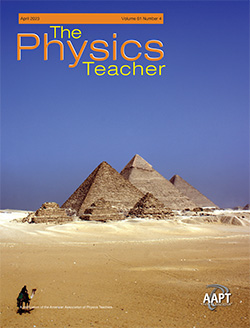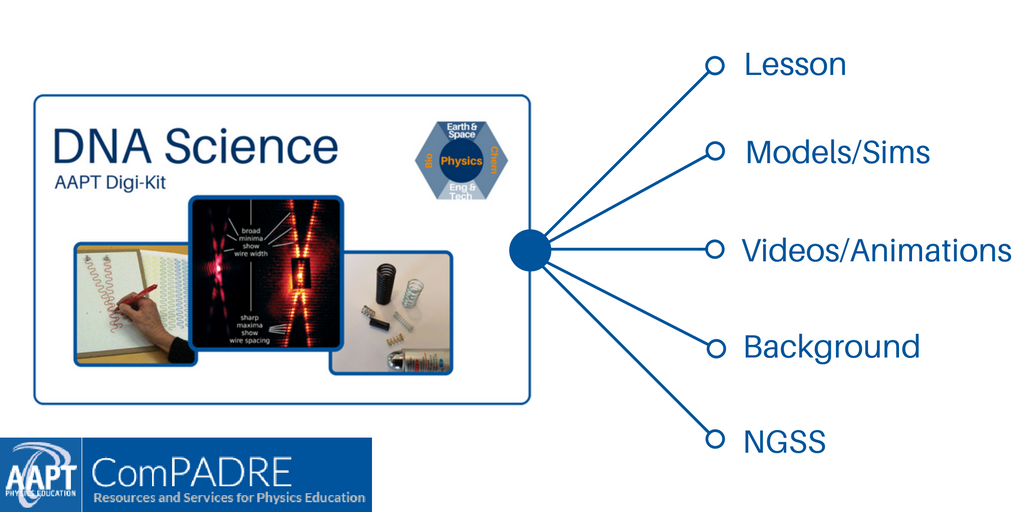
The Physics Teacher
April 2023
Volume 61 Issue 4
This month's cover shows the pyramids of Giza against a backdrop of azure, but does not show the cosmic ray muons that are streaming through the pyramids. Don Lincoln’s article “Using cosmic rays to see the unseeable" ; tells of recent efforts by physicists to identify previously undetected voids in these pyramids by using cosmic ray muons.
Columns
And the Survey Says..., Astronotes, Figuring Physics, For the New Teacher, Just Physics, iPhysicsLabs, Little Gems, Physics Challenge for Teachers and Students, Fermi Questions, Talkin' Physics, Technology In The Classroom, Tricks of the Trade, Visual Physics, and Websights.
LETTERS TO THE EDITOR
Clarification to the article “The New Definitions of the Mole and Kilogram: How and Why These SI Units Took their New Status,” by Phys. Teach. 58, 477–479 (2020) Jean-Francois Gal and Richard Davis. DOI: 10.1119/5.0077854
Alternative Solution to the September 2022 Challenge “Second to one” by Krzysztof Rębilas. DOI: 10.1119/5.0139427
In memory of Thomas D. Rossing by Chris Chiaverina and Andrew Morrison. DOI: 10.1119/5.0144691
AWARDS
AAPT Fellowship awarded to Gelderman at 2023 Winter meeting. DOI: 10.1119/10.0017697
PAPERS
Lessons for Instructor–Student Interactions in Physics from the World of Improvisational Theater by Colin G. West. DOI: 10.1119/5.0076745
Using Cosmic Rays to See the Unseeable by Don Lincoln. DOI: 10.1119/5.0143816
The Yellow Light Problem in a Biological Context by Arthur Eisenkraft. DOI: 10.1119/5.0084232
Meshchersky Ladders by Mark Denny. DOI: 10.1119/5.0074610
Newton’s Cradle with Two Balls by Rod Cross. DOI: 10.1119/5.0082363
Arch and Cable Suspended Bridges by Miguel Lagos, Milton Elgueta and Mario I. Molina. DOI: 10.1119/5.0070682
What Did James Watt Really Invent? by Thomas B. Greenslade Jr. DOI: 10.1119/5.0048353
Tracking Parabolic Trajectories with a Mobile Phone by Luis Manuel Tobaja and Julia Gil. DOI: 10.1119/5.0066629
A Simulation Experiment Using Algodoo: What Force Makes a Car Accelerate, and What Does the Acceleration Depend On? by Tamás Radnai, Tünde Tóthné Juhász, András Juhász and Péter Jenei. DOI: 10.1119/5.0059836
A Useful Experiment for Teaching Resistance of a Wire as a Function of Temperature by Milan Kovacevic, Marko Milosevic and Ljubica Kuzmanovic. DOI: 10.1119/5.0089514
Small Direct Current Electric Motors by Thomas B. Greenslade Jr. DOI: 10.1119/5.0048352
Experimental Verification of the Temperature Coefficient of Resistivity by Robert Polak, Michael R. Harris, Kiet A. Nguyen and Anthony Kearns. DOI: 10.1119/5.0083668
Origin of the Laplace Force Applied to a Current-Carrying Wire Immersed in a Magnetic Field by Marco Finazzi and Maurizio Zani. DOI: 10.1119/5.0096757
A Modified Peer Instruction Protocol: Peer vs. Teacher’s Instruction by Boon Leong Lan, Pooi Mee Lim and Patrick W. C. Ho. DOI: 10.1119/5.0071188
Student-Created Physics Problems as an Independent and Equitable Assessment Tool by Bruce A. Schumm, Joy Ishii and Colin G. West. DOI: 10.1119/5.0088227
Energy Conservation Analysis Using Arduino by Atakan Çoban, Niyazi Çoban and Emine Çoban. DOI: 10.1119/5.0067534
Static Equilibrium in a Uniform Gravitational Field by Adel Alameh. DOI: 10.1119/5.0060067
Atmospheric Pressure vs. a Gigantic Barrel by Salam Sassine Sakr and Tarek Harb. DOI: 10.1119/5.0081290
Application of the Oscillation Concept: Measuring the Human Respiration Rate in Various Activities Using a Smartphone’s Magnetometer Sensor by Prasetyo Listiaji, Angelina Amalia Putri and Tiara Dwi Wulandari. DOI: 10.1119/5.0060098
Race and Physics Teaching Collection Resource
Race and Physics Teaching Continued May 2020-January 2021
DNA Science Lesson & Digi-Kit
Inspired by an article from The Physics Teacher, this multidisciplinary lesson and digital resource collection is based on How Rosalind Franklin Discovered the Helical Structure of DNA: Experiments in Diffraction (Braun, Tierney, & Schmitzer, 2011). Click the image to access this resource.


